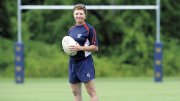Rugby has its own language. Even if you haven’t watched a full match (80 minutes, in two 40-minute halves), you may be familiar with the scrum, a fun word to say, and, for the uninitiated, a bizarre phenomenon to watch: players link arms, bow their heads, and push forward against a likewise engaged opposing team, all the while attempting to gain control of the ball (a chunkier, more ovoid version of a football) with their feet. It looks like a mindless people pile-up. But it’s not, as Sue Parker, Harvard’s first coach of varsity women’s rugby, can explain.
“There is an element of brute force,” concedes Parker, who most recently coached the women’s rugby team at the U.S. Naval Academy. “But you’d be surprised—there’s also tremendous technique involved. At Navy, we were a smaller team than a lot of those we played against. But if you have strong fundamentals, a less powerful scrum can still win the ball.”
That’s rugby in a nutshell—a contact sport played without padding that rewards sheer strength while demanding the technical skills of passing, kicking, carrying, and tackling in pursuit of a try, the five-point equivalent of football’s six-point touchdown. (Kicking the ball through the goalposts will earn two more points for a conversion; a field goal, worth three points, can be attempted at any time.) Players usually pass by throwing underhand, and can pass only backward or sideways, not forward; defenders can tackle only the player carrying the ball; and as soon as a player is tackled, anyone from either team can immediately pick up the ball and start a new attack by kicking, passing, or running with it. Sometimes players form an unruly pack, or a ruck, over a loose ball, in an attempt to push it toward the try line; a maul, on the other hand, occurs when players converge on an unfortunate ball-carrier who has been tackled but not taken to the ground.
The no-pads, high-contact aspect of rugby is part of its fearsome mystique, and Parker teaches the art of tackling with great care. “We show where your feet need to be in relation to the ball-carrier, and the proper angle of your torso in relation to your hips and thighs,” she says. “Where do you squeeze and drive through [to make the tackle]?” (You do it in the ball-carrier’s waist-thigh region.) “We repeat this slowly and under careful observation until a player has confidence that she’s doing it safely and in the right position. Then we have the ball-carrier start running.” Through some odd calculus, this close, sometimes ruthless contact on the field creates a legendary culture of camaraderie off the field: “You play a brutal, super-intense match against your opponents, and afterwards, eat pizza together,” says Parker. “There aren’t many sports where that’s the case.”
Rugby most often has 15 players to a side, but can also be played with seven, which is how Parker first experienced the game as a law-school graduate in her early twenties. “I was working for a big firm in D.C. and not enjoying how my lifestyle had become so completely sedentary,” she says. She had always been a student athlete, competing in the javelin throw and 800-meter run at the University of Maryland, but rugby was something completely new: “It had everything I loved—raw speed, kicking, passing, and an unbelievable level of teamwork.” Parker was hooked. She started playing on community teams and worked her way up to coaching jobs, practicing law throughout. Only now—with the Harvard position—is she focusing on rugby full-time.
Since her rugby epiphany in 1991, Parker has competed as a member of the USA Rugby 7s Eagles, the country’s national amateur team, and gone on to coach that squad; the Washington D.C. Furies, a club team; and Navy. This summer, she took a team of Navy players to the World University Games in Kazan, Russia, where they finished with a 1-6 record; they were the first American team to play rugby at these Games, where they competed against national teams from the other countries. As chair of the USA Rugby Women’s Collegiate Strategic Committee, Parker led efforts to promote the sport to NCAA varsity status.
Harvard is the first Ivy League college to sponsor a varsity women’s rugby program, which launches this fall—although as a club sport it dates back to 1982 for the women’s team and to 1872 for the men’s. The Crimson women won national titles as a rugby club in 1998 and 2011. (Only the women’s program is going varsity. Parker believes it will be good for the Harvard men’s club as well, and she has already reached out to the male ruggers.)
The other Ivy colleges all have women’s club teams. Parker’s goals for the season include winning the Ivy Rugby Conference, which embraces those club teams and Harvard’s varsity. (As the NCAA classifies rugby as an “emerging sport,” it sanctions official competition between varsity and club squads.) She also wants to support the club players as they make the transition to the more intense level of physical and mental commitment that a varsity sport requires. And Parker plans to cast a wide recruiting net. “I think the fact that I didn’t have significant team-sport experience helps me relate to players who are coming to rugby for the first time,” she says. “Why not bring everything to the table and be extremely creative in how we apply strategies and techniques from sports like soccer and lacrosse to rugby, to see if we can catch other teams off guard? No matter what your physical dimensions, there’s a place for you on the field if you’re curious, motivated, and devoted to becoming a student of the game.”









